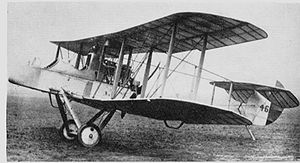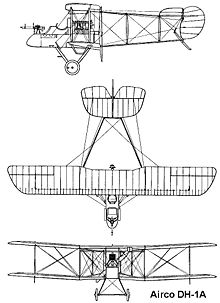Airco DH.1 Video - RC Scale model
|
|
Airco DH.1
DH.1

Role: Two seat fighter / General purpose aircraft
Manufacturer: Airco
Designed by: Geoffrey de Havilland
First flight: 1915
Introduced: 1915
Retired: 1918
Primary user: Royal Flying Corps
Number built: ~170
The Airco DH.1 was an early military biplane flown by Britain's Royal Flying Corps during World War I.
Design and development
Geoffrey de Havilland was one of the pioneering designers at the Royal Aircraft Factory and was partially or wholly responsible for most pre-war "Factory" designs. When he left to become chief designer at The Aircraft Manufacturing Company (Airco) in 1914, his first design was strongly reminiscent of the F.E.2b, one of his last designs for the Royal Aircraft Factory. Like the F.E.2, the DH.1 was of pusher configuration, the aircraft accommodating its pilot and observer in two open tandem cockpits in the nose, the observer's cockpit stepped down below the pilot's and equipped with a machine gun. The wings were of typical fabric-covered, two-bay, unstaggered, unswept, equal span design, while the stabiliser and rudder were carried on the end of a long, open-framework boom.
The type, like the F.E.2b, was designed for the 120 hp (89 kW) Beardmore 120 hp water cooled inline engine. However, all available Beardmore engines had been ordered for F.E.2b production, so the 70 hp (52 kW) Renault 70 hp aircooled V8 engine was installed instead. With this powerplant the DH.1 was underpowered - but still had a creditable performance, and was ordered into production. Airco was already occupied with later designs, so DH.1 production was undertaken by Savages of King's Lynn.
Late production machines were fitted with the Beardmore, as the DH.1A.
Operational history
The DH.1 saw operational service only in the Middle East theatre, where a few Beardmore powered DH.1As arrived in July 1916 - these were used by No. 14 Squadron RFC as escorts for their B.E.2 reconnaissance aircraft. An Aviatik two seater was claimed by a 14 Squadron D.H.1A in August for the only known victory of the type. The last known action by a DH.1 was on 5 March 1917, when one was shot down during a bombing raid on Tel el Sheria. No. 14 Squadron became an R.E.8 unit in November 1917 - and it seems probable the last operational DH.1 had gone before that date.
The other DH.1s served in training and Home defence units in the United Kingdom, finally being withdrawn from service in 1918.
Variants
DH.1:101 examples powered by Renault engine
DH.1A :some 70 examples powered by Beardmore engine
Operators
United Kingdom
Royal Flying Corps
No. 14 Squadron RFC
Specifications (DH.1)

Picture - 3-view
Data from De Havilland Aircraft since 1909
General characteristics
Crew: two (pilot and observer)
Length: 28 ft 11â
in (8.83 m)
Wingspan: 41 ft 0 in (12.50 m)
Height: 11 ft 4 in (3.46 m)
Wing area: 426 sq ft (39.6 m²)
Empty weight: 1,356 lb (616 kg)
Loaded weight: 2,044 lb (927 kg)
Powerplant: 1x Renault, 70 hp (50 kW)
Performance
Maximum speed: 80 mph (70 kn, 130 km/h)
Rate of climb: 350 ft/min (1.7 m/s)
Armament
1 machine gun for observer
Comparable aircraft
Royal Aircraft Factory F.E.2
Cheesman, E.F. (ed.) Reconnaissance & Bomber Aircraft of the 1914-1918 War. Letchworth, UK: Harleyford, 1962.
Grey, C.G. Jane's all the world's aircraft 1919 (reprint). New York: Arco Publishing Company, 1969. ISBN 0-0001-890-1.
Jackson, A.J. De Havilland Aircraft since 1909. London:Putnam, Third edition, 1987. ISBN 0 85177 802 X.
Taylor, Michael J.H. Jane's Encyclopedia of Aviation, 1989 edition. London: Studio Editions, 1989, p. 45. ISBN 0-51710-316-8.
Airco DH.1 Pictures and Airco DH.1 for Sale.
Living Warbirds: The best warbirds DVD series.
Source: WikiPedia